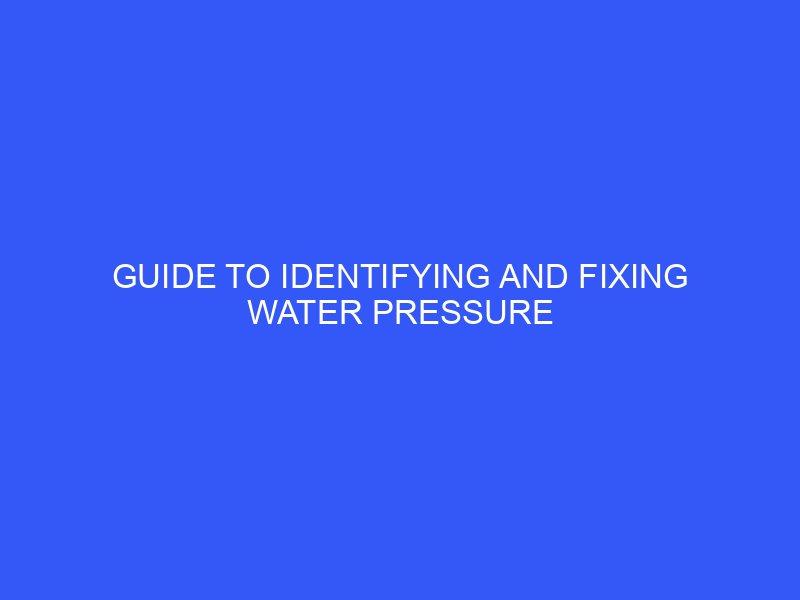Water pressure is an essential component of every plumbing system. A continuous, appropriate water pressure is vital for a smooth and efficient experience when showering, doing laundry, or washing dishes. However, many households frequently experience the inconvenient problem of low water pressure, which can disrupt everyday routines and cause inconvenience.
Common Water Pressure Issues: Recognizing and Addressing Low Pressure
In this post, we will look at the most prevalent reasons for low water pressure and offer effective remedies to the problem.
Identifying Low Water Pressure
Before delving into the options, it is critical to determine whether you have low water pressure. The following are some common indications of low water pressure:
- Dripping or insufficient flow from faucets and showerheads
- More time to fill a bathtub or sink
- Unusual plumbing fixture noises, such as bubbling or buzzing
If you see these indicators, it’s essential to investigate and determine the core reason for your home’s low water pressure.
Possible Causes of Low Water Pressure
A variety of circumstances can cause low water pressure. Understanding these variables permits you to pinpoint the issue and make a proper move. Among the most widely recognized offenders are:
Water Leaks
Leaky pipes can have a substantial impact on your home’s water pressure. Even minor leaks might cause a significant reduction in pressure over time. Examine your pipes for signs of damage, and consider calling a professional plumber to address any leaks as soon as possible.
Clogged Pipes
Pipes can develop mineral deposits, rust, or debris over time, resulting in jams restricting water flow. A clogged pipe can cause pressure to drop throughout your plumbing system. It is best to seek the advice of a professional plumber who can examine the situation and propose the best solution, such as pipe cleaning or replacement.
Faulty Pressure Regulator
Water pressure entering the house is controlled by homes that have a pressure regulator. If the pressure regulator fails, the optimal water flow is disrupted, resulting in low water pressure. Consider hiring a plumber to inspect and, if necessary, modify or replace the pressure regulator.
Municipal Water Supply Issues
Low water pressure is sometimes caused by a problem with the municipal water supply rather than a problem in your home. Water pressure in your area may be reduced due to excessive demand, maintenance work, or pipe bursts in municipal systems. Contact your local water provider for more information if this is the case.
Resolving Low Water Pressure
Now that you’re aware of the many causes let’s look at some practical solutions to low water pressure:
Check for Leaks
Begin by looking for leaks in your plumbing system. Examine any visible pipes, faucets, showerheads, and toilets for leaks. If any leaks are discovered, fix or replace the affected components. Remember that even a minor leak might result in significant pressure loss over time.
Clean or Replace Clogged Pipes
Consider expert pipe cleaning or replacement if you feel clogged pipes are the source of poor water pressure. A plumber can analyze the level of the clog and advise on the best course of action to restore proper water flow.
Adjust or Replace the Pressure Regulator
If the pressure regulator fails, it must be adjusted or replaced. A plumber can decide the best solution based on the unique problem. A pressure regulator that has been changed or replaced will ensure the proper water pressure enters your home.
Consult with Your Water Provider
If you have ruled out internal plumbing difficulties and believe the problem is with the municipal water supply, you must contact your local water supplier. They can tell you about any ongoing repairs, maintenance work, or other concerns affecting your local water pressure.
Fixing High Water Pressure: A Guide to Plumbing System Stabilization
We’ll lead you through the steps to fix excessive water pressure in this detailed guide, providing helpful insights and practical solutions.
The Significance of Settling Your Plumbing System
Before we go into the numerous ways of fixing excessive water pressure, we should first comprehend the reason why stabilizing your plumbing system, in any case, is so significant.
- Prevent Damage: Excessive water tension can unleash devastation on your pipes, appliances, and fixtures, bringing about leaks, explosions, and costly fixes.
- Save Water: Excessive water pressure causes wasteful water utilization, which prompts higher service bills.
- Extend the Life of Your Plumbing System: Stabilizing your plumbing system not only prevents damage but also maintains its general durability, decreasing the need for regular repairs and replacements.
- Peace of Mind: With a reliable plumbing system, you may relax knowing you have reduced the chance of water-related problems.
Identifying High Water Pressure
Before you start correcting the problem, you must first determine whether you have high water pressure. Here are some frequent warning indicators to check for:
- Noisy Pipes: If you hear banging or rattling sounds when using your fixtures, this could indicate high water pressure.
- Leaking Installations: Over-the-top water tension can cause consistent leaks, especially from faucets and lavatories.
- Short Appliance Life expectancy: If your appliances are continually breaking down, high water tension could be the reason. These appliances incorporate dishwashers and washing machines.
- Surprising Water Stream: If water spouts out of your faucets with extraordinary power, this is a symptom of high water pressure.
Fixing High Water Pressure
Install a Pressure Reducing Valve (PRV)
The most popular and efficient solution for high water pressure difficulties is a Pressure Reducing Valve (PRV). A PRV is put in the main water supply pipe and regulates the water flow to keep it safe and stable. The following are the essential steps for installing a PRV:
- Turn off the primary water supply.
- Find the main water line and ensure enough room for the PRV.
- Using the necessary fittings, connect the PRV to the water line.
- Set the pressure setting on the PRV to the desired level.
- Check for leaks by turning on the main water supply.
Install an Expansion Tank
Adding an expansion tank to your plumbing system might aid in the reduction of high water pressure. It absorbs excess pressure induced by thermal expansion, hence reducing pressure buildup. This is how to put in an expansion tank:
- Determine an appropriate position for the expansion tank near the water heater.
- Turn the main water supply off.
- To remove any pressure, drain the plumbing system.
- Connect the cold water supply pipe to the expansion tank.
- Fasten the tank securely and check for good alignment.
- Turn on the water and look for any leaks.
Seek Professional Help
If you need more clarification about managing plumbing jobs independently, or if the problem persists, it is better to get professional help. A professional plumber can precisely assess the problem and give competent remedies tailored to the needs of your plumbing system.
Final Thoughts
If left untreated, high water pressure can cause substantial damage to your plumbing system. Avoid costly repairs, save water, and preserve the longevity of your plumbing system by stabilizing it. Remember to recognize the indicators of high water pressure, consider installing a Pressure pressure-reducing valve (PRV) and expansion tank, and don’t be afraid to seek expert assistance if necessary.
Stabilizing your plumbing system is a long-term investment that will provide you with a more efficient, dependable, and worry-free water supply system for your home.
FAQ’S
How do you diagnose water pressure problems?
Turn the valve on and check the reading after fitting the test gauge onto the spout. This will display the water pressure at the hose spigot, which is usually sufficient to identify a water pressure problem in the residence.
What causes poor water pressure?
Your water pipes can get blocked with scale and constricted by corrosion. Plumbing issues that result in low water pressure are common in systems with older galvanized iron pipes, which can rust as a result of the pH level of the water.
How do I increase water pressure in my water system?
Look for a conical valve with a bolt poking out of the cone on the main supply line near your water meter. Turn the bolt clockwise after loosening the locknut to increase pressure.


